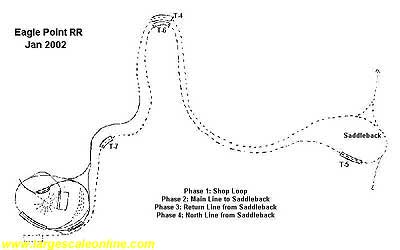

|

|
Big Trains
An Introduction to 7 1/2" trains.
May 21, 2002


By Rick Henderson
LSOL.com Associate Editor |
Author
Bio
The biggest difference in 7 1/2" gauge model railroading is that you ride on your trains instead of watching it go by.
|


Click for larger picture

Click for larger picture

Click for larger picture

Click for larger picture

Click for larger picture
| Over many years there has been one constant in my life, railroading, model and real. It started off at the age of 7 with a Half O model railroad set up that we would put on the dining room table in the early 50's. Since then I have modeled in most of the model railroad scales, never restricting myself to following one prototype line, but enjoying the hobby as a whole. I even spent a few years at a transportation museum where I learned how to lay track and build turnouts, run locomotives and restore trains in 1:1 or 4' 8 1/2" standard gauge.
Until recently I was very involved in 1:20n36 or large scale modeling of 3' narrow gauge railroading on a large indoor layout. A relocation and contract to write a book has found all of those railroad items now in storage. However my railroading habit has not been denied and in fact has been broadened to interesting new horizons.
I was invited into a 7 1/2" gauge club where the members motive power is live steam locomotives and battery or gasoline powered, diesel and electric locomotives. The biggest difference in 7 1/2" gauge model railroading is that you ride on your trains instead of watching it go by. Once you run one of these trains across track you helped build you can easily be hooked on this hobby.
For the most part, 7 1/2" gauge railroading is not your average back yard hobby. This is largely due to the fact you need over 100' to make a decent turn as opposed to 12' in the typical Garden Railways. Though many people have built a home 7 1/2" gauge track, most layouts are built and maintained by clubs. |


Click for larger picture
Chattanooga Society of Model Engineers & the Eagle Point Railroad. The Eagle Point Railroad (EPRR) is a private 7.5 inch gauge railroad. Located northwest of Chattanooga, Tennessee, it is situated on 80 acres of beautiful land, wooded hillsides, streams, and massive rock formations. It is also the current home of the Chattanooga Society of Model Engineers (CSME). Together they are building a scale railroad that winds deep into the wooded hillsides, across streams, and past massive rock formations.
The mainline route will take you over the summit, across a curved trestle and up to the Saddleback wye located between two rocky ridges. You will continue down a 1200' long 2% down grade to the lowest point on the railroad and cross the first of three trestles on the long 1200' 2% climb back up to the Eagle Point shop loop. See the proposed layout plan.
The Eagle Point shop loop is now complete, allowing for continuous running, and was officially opened on July 14 during a Golden Spike ceremony. Shortly there after the wye and passing siding were completed. |
| So where do clubs build their layout? On public land with the agreement to be open to the public and usually they must be a chartered non-profit organization. Or on private land with some standing agreement with the owner on usage. This option is often on one of the club member's own properties. The best location would be on private, club owned, land but this is infrequently the case due to costs involved. You can find clubs with just one small loop or as large as one with 11 miles of mainline track on 2000 acres.
In 7 1/2" gauge you find all of the same interesting aspects of railroading that you find in other modeling scales. Your approach to dealing with building, operating and maintaining 7 1/2" gauge railroads is more realistic due to the size you are working in. |
The fact that you will have people riding your trains means you have to build to better standards than you could get away with in smaller scales. When, for example, you build a trestle, it will have to support over 1000 to 1500 pounds as opposed to the 10 to 15 pounds a garden railway engine may weigh.


Click for larger picture

Click for larger picture

Click for larger picture

Click for larger picture

Click for larger picture
| The most basic component of any operational railroad is its track. Few people realize how much work actually goes into laying track for these trains. You have to actually survey the land you will use and prepare the ground to the correct maximum useable grade. In building up or cutting down the terrain you have to also allow for water and other weather elements when you build up your sub-roadbed.
Then comes a 3" to 4" layer of gravel that must be leveled so there is no side-to-side tilt in the future. Next comes the actual track ties and rail, often made up in 10' panels. Then comes more gravel ballast between and on the outside of the ties to keep the track in place. This is a lot of time consuming work but necessary for safe operations.
So what trains are available in 7 1/2" gauge railroading? Well, here your ready to run selections are very limited and most of your actual live steam locomotives are scratch built by their owners. There are kits, although these may require a lot of machining work and fabrication of some of the components. There is also a fair collection of used steam engines on the market. As with the prototype steam engines, these models require a lot of work to fire up, maintain pressure and then cool down. When you have a live steam engine fired up, you have a full time job on your hands. |
Though the hobby started out and is often referred to as "Live Steam Railroading", diesel models come ready to run from several manufacturers. Gasoline engines or rechargeable batteries usually power these locomotives. They turn on and off easily and have become popular in the hobby. If you want a new diesel locomotive it would be rare to find one in stock. Most are custom built with your order and can take from 6 weeks to 6 months or more.


Click for larger picture

Click for larger picture

Click for larger picture
| The cars in 7 1/2" gauge railroading come in three basic categories, working, non-riding models or riding cars. Working cars are flats and gondolas used to carry materials or tools to build the railroad and hoppers used to carry and spread the gravel ballast.
Non-riding scale models are usually freight or passenger cars and are strictly for show. A variety of riding cars come designed either after actual railroad cars or as a flat car with seats or a bench mounted on the car.
Do you have to invest in equipment to enjoy the hobby of 7 1/2" gauge railroading? Not usually. Though a few clubs would require members to actually have or obtain large scale equipment to be a member, most clubs welcome people interested in helping to build and maintain a club layout. Many are also very willing to let you have the throttle after they get to know you.
There is a lot more to the hobby, this is just an introduction into a whole new world of railroad modeling. |
| 7.5 in ga |
Then there are some of us in the 15 in ga., 5 in. scale world. Where we have automatic brakes, 40 plus page rule books, and State inspections four times a year. See this website, still under construction, at www.hillcrestreedley.com. Garden RR, 7.5in.,15in are all uniquely the same and unrelated at the same time. It's all good fun and hard work. |
| Kell Schmidt - 05/28/2009 - 12:01 |
| Where do find the trains? |
| 7.5 has to be the best thing since HO flex track. |
| Tice N Leonard Jr - 07/21/2010 - 09:01 |
| Riding Scale Railroad Listings |
| At discoverlivesteam.com scroll down to Railroad listings and follow that link. |
| Rick Henderson - 07/21/2010 - 09:12 |
Top of Page
|
|

|
IMPORTANT LINKS

Get Your Official Diploma

Watch New Videos


New Products Online
|
|



